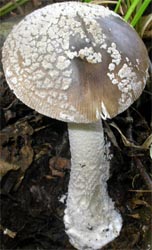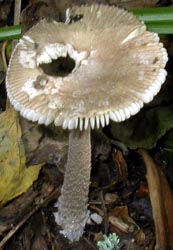|
[ Section Amanita page. ] [ Amanita Studies home. ] [ Keys & Checklist/Picturebooks ] Amanita friabilis (Karst.) Bas=Amanita alnicola Rouzeau & F. Massart nom. inval. =Amanita sternbergii Velen. "Alder Amanita"
Technical description (t.b.d.) BRIEF DESCRIPTION: The description that follows is based on the collecting notes with collections in the Netherlands National Herbarium in Leiden and from observations supplied by prof. Pierre-Arthur Moreau (Univ. Lille). The cap of A. friabilis is 28▒ (-70) mm wide, plano-convex, with a slightly depressed center, with a low umbo in the middle, brown, glabrous, thin-fleshed, with a sulcate-striate margin (25▒ - 30% of the radius). The volva is present as dry, pruinose, densely set, persistent gray to whitish warts. The gills are crowded, just reaching the stem apex, narrowly adnate, and pale buff to whitish. The stem is 48▒ (-140) x 6▒ mm, hollow, pallid, with brownish squamules in places. The volva is present as brownish, wartlike remnants with a narrow, appressed, adnate vaginate volva. The spores measure 10.1 - 12.1 x 8.5 - 9.8 (-10.8) Ám and are inamyloid and subglobose to broadly ellipsoid (rarely ellipsoid, sometimes obovoid). Clamps are absent at bases of basidia. This species has only been found in moist soils in association with alder. It was originally described from Finland and is widely reported in Europe from west to east and, at least, from Finland and Scandinavia to southern France. For comparison, see Amanita basiana Tulloss & M. Traverso. A set of similar clampless species is listed under A. farinosa Schwein. -- R. E. Tulloss Photos: Dr. Jan Borovička (first row, leftmost, Bavaria, Czech Republic) [ Section Amanita page. ] [ Amanita Studies home. ] [ Keys & Checklist/Picturebooks ] Last changed 13 October 2009. |




